

Cambrian. Cambrian explosion. The Cambrian explosion has generated extensive scientific debate.

The seemingly rapid appearance of fossils in the “Primordial Strata” was noted as early as the 1840s,[14] and in 1859 Charles Darwin discussed it as one of the main objections that could be made against the theory of evolution by natural selection.[15] The long-running puzzlement about the appearance of the Cambrian fauna, seemingly abruptly and from nowhere, centers on three key points: whether there really was a mass diversification of complex organisms over a relatively short period of time during the early Cambrian; what might have caused such rapid change; and what it would imply about the origin of animal life.
Interpretation is difficult due to a limited supply of evidence, based mainly on an incomplete fossil record and chemical signatures remaining in Cambrian rocks. Key Cambrian explosion events Gaskiers glaciationArchaeonassa-type trace fossils. Lagerstätte. Types[edit] Palaeontologists distinguish two kinds:[1] Konzentrat-Lagerstätten (concentration Lagerstätten) are deposits with a particular "concentration" of disarticulated organic hard parts, such as a bone bed.
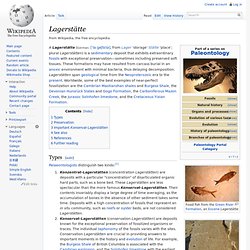
These Lagerstätten are less spectacular than the more famous Konservat-Lagerstätten. Cryptobiotic soil. Biological soil crusts are communities of living organisms on the soil surface in arid- and semi-arid ecosystems.
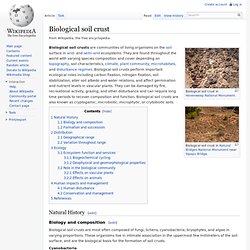
They are found throughout the world with varying species composition and cover depending on topography, soil characteristics, climate, plant community, microhabitats, and disturbance regimes. Biological soil crusts perform important ecological roles including carbon fixation, nitrogen fixation, soil stabilization, alter soil albedo and water relations, and affect germination and nutrient levels in vascular plants. They can be damaged by fire, recreational activity, grazing, and other disturbance and can require long time periods to recover composition and function. Margaretia. Margaretia is a frondose organism known from the middle Cambrian Burgess shale.[1] Its fronds reached about 10 cm in length and are peppered with a range of length-parallel oval holes.
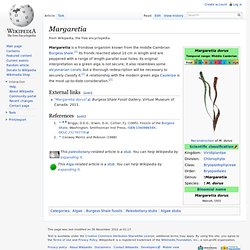
Its original interpretation as a green alga is not secure; it also resembles some alcyonarian corals, but a thorough redescription will be necessary to securely classify it.[1] A relationship with the modern green alga Caulerpa is the most up-to-date consideration.[2] External links[edit] "Margaretia dorus". Burgess Shale Fossil Gallery. Virtual Museum of Canada. 2011. References[edit] Dalyia. Ediacara biota. Arthropod. Their vision relies on various combinations of compound eyes and pigment-pit ocelli: in most species the ocelli can only detect the direction from which light is coming, and the compound eyes are the main source of information, but the main eyes of spiders are ocelli that can form images and, in a few cases, can swivel to track prey.
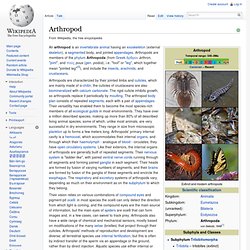
Arthropods also have a wide range of chemical and mechanical sensors, mostly based on modifications of the many setae (bristles) that project through their cuticles. Arthropods' methods of reproduction and development are diverse; all terrestrial species use internal fertilization, but this is often by indirect transfer of the sperm via an appendage or the ground, rather than by direct injection.
Aquatic species use either internal or external fertilization. Almost all arthropods lay eggs, but scorpions give birth to live young after the eggs have hatched inside the mother. Trilobite. Trilobites had many life styles; some moved over the sea-bed as predators, scavengers or filter feeders and some swam, feeding on plankton.
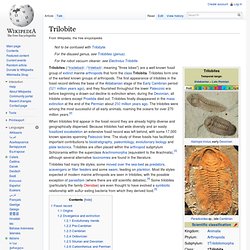
Most life styles expected of modern marine arthropods are seen in trilobites, with the possible exception of parasitism (where there are still scientific debates).[4] Some trilobites (particularly the family Olenidae) are even thought to have evolved a symbiotic relationship with sulfur-eating bacteria from which they derived food.[5] Fossil record[edit] All Olenellina lack facial sutures (see below), and this is thought to represent the original state. Archaeocyatha. Preservation[edit] Geological history[edit]
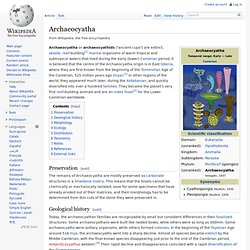
Extinction event. The blue graph shows the apparent percentage (not the absolute number) of marine animalgenera becoming extinct during any given time interval.
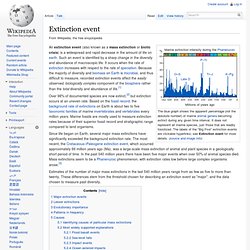
It does not represent all marine species, just those that are readily fossilized. The labels of the "Big Five" extinction events are clickable hyperlinks; see Extinction event for more details. (source and image info) Since life began on Earth, several major mass extinctions have significantly exceeded the background extinction rate. The most recent, the Cretaceous–Paleogene extinction event, which occurred approximately 66 million years ago (Ma), was a large-scale mass extinction of animal and plant species in a geologically short period of time. Pannotia. Pannotia (550 Ma).

Pannotia, first described by Ian W. D. Dalziel in 1997, is a hypothesized supercontinent that may have existed from the late Neoproterozoic Pan-African orogeny, about 600 million years ago, to the end of the Precambrian, about 541 million years ago. It is also known as the Vendian supercontinent. Gondwana. The adjective Gondwanan is in common use in biogeography when referring to patterns of distribution of living organisms, typically when the organisms are restricted to two or more of the now-discontinuous regions that were once part of Gondwana, including the Antarctic flora.
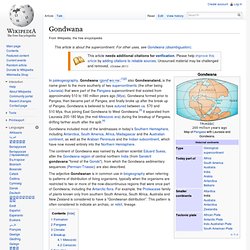
For example, the Proteaceae family of plants known only from southern South America, South Africa, Australia and New Zealand is considered to have a "Gondwanan distribution". This pattern is often considered to indicate an archaic, or relict, lineage.